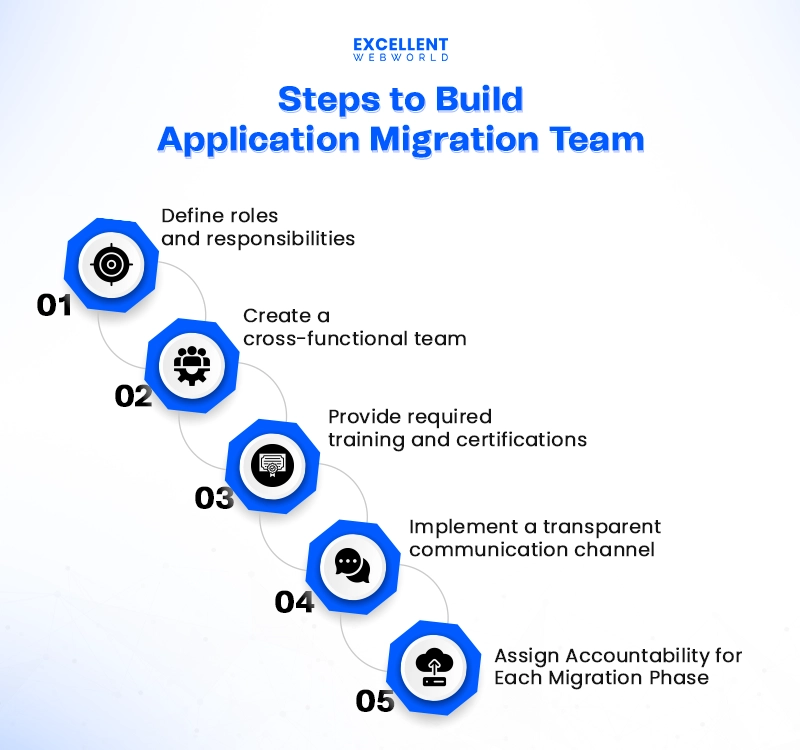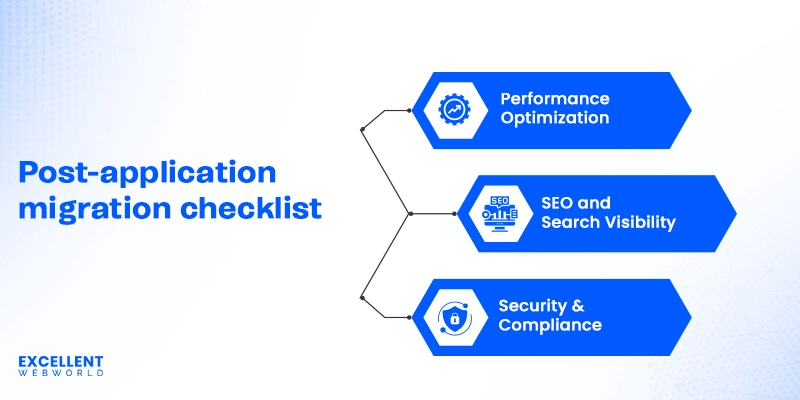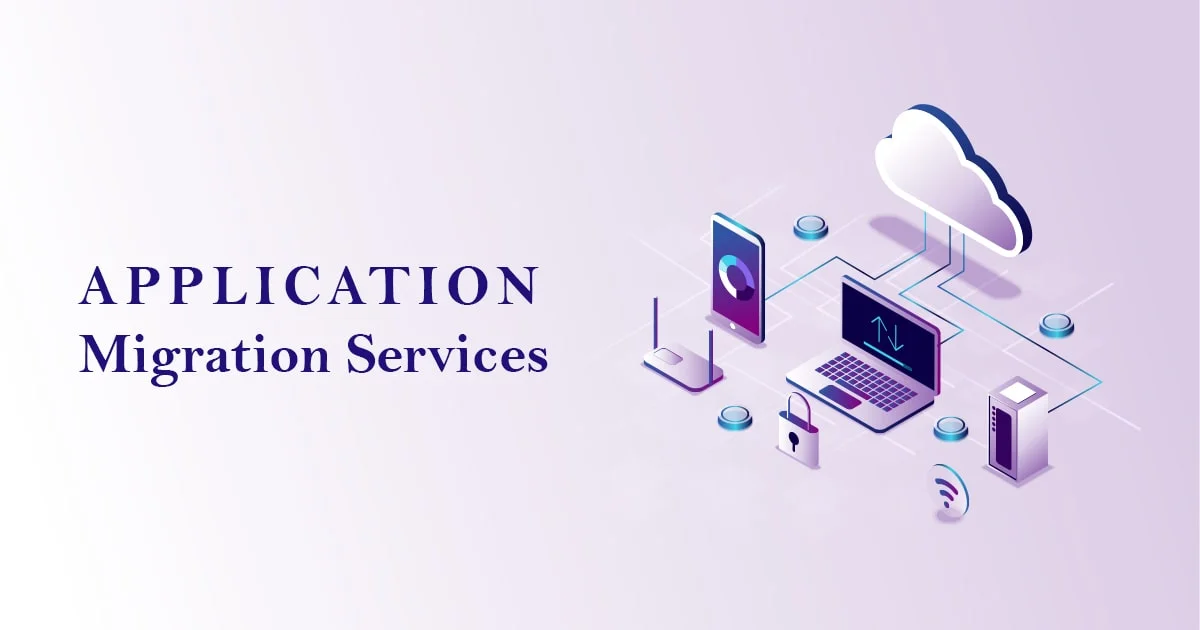Does your business manage data into legacy system leads to rising IT cost and lack of performance? If it is so, migrating solutions to cloud platforms can be the ideal solution, but without pre-planned cloud migration strategies, 83% of cloud migration projects fail or exceed their budgets due to poor planning.
Migrating applications to the cloud is not just about transferring data; it’s also about optimizing performance, managing data, and ensuring streamlined operations. Many businesses conducting migration process might face unexpected downtime, security risks, and integration failures. But they can reduce this by outsourcing to cloud migration service providers for smooth transition process.
So, to ensure a secure and efficient cloud migration, we have compiled a comprehensive Application Migration to Cloud Checklist and necessary points to consider.
Follow this checklist to:
What is Cloud Migration?
Cloud migration is the process of transferring data, apps and workloads from on-premise data architecture into the cloud to significantly enhance business operations. By migrating your online data, assets, IT resources, databases, and apps from legacy systems to cloud platforms (AWS, Google Cloud, Azure), you can boost productivity, security, and scalability. This transition can also provide the enhanced benefits of both data management systems, such as cost savings, automation, enhanced security, and real-time monitoring. However, without a well-thought-out and strategic cloud migration plan, it might lead to failures and performance issues. Cloud application development and migration can be done by following a predetermined process that helps create a smooth workflow.
Quick Overview of Cloud Migration Checklist for Success
The cloud data migration process must be done seamlessly with a predetermined set of strategies. So, you can follow the below-mentioned migrating to the cloud checklist and steps without hampering the routine activities:
| Step | Action | Purpose | Key Considerations | Best Practices |
|---|---|---|---|---|
| Step 1 | Define Business Goals | Align cloud migration with strategic objectives | Identify key drivers: cost savings, scalability, innovation, or disaster recovery | Set measurable KPIs (e.g., cost reduction, performance improvement) |
| Step 2 | Assess Current Infrastructure | Identify application dependencies and resource utilization | Evaluate legacy systems, workloads, and dependencies | Use cloud assessment tools (AWS Migration Hub, Azure Migrate) |
| Step 3 | Select Cloud Provider | Choose the best-fit cloud platform | Compare AWS, Azure, and Google Cloud based on pricing, features, and compliance | Consider hybrid/multi-cloud options for flexibility |
| Step 4 | Choose Migration Strategy | Determine how to move workloads to the cloud | Select from lift-and-shift, replatform, refactor or rebuild | Prioritize applications based on complexity and business impact |
| Step 5 | Prepare Data & Dependencies | Map integrations and ensure compatibility | Analyze data structures, storage needs, and API integrations | Optimize data formats and ensure data consistency before migration |
| Step 6 | Build a Skilled Team | Assign roles for successful migration | Identify gaps in cloud expertise and upskill teams | Use a mix of in-house talent and external cloud specialists |
| Step 7 | Design Cloud Architecture | Optimize security, scalability, and performance | Define resource allocation, network topology, IAM policies | Leverage auto-scaling, load balancing, and containerization (Kubernetes) |
| Step 8 | Ensure Security & Compliance | Implement IAM, encryption, and governance | Address data privacy, encryption, access control, and regulatory requirements | Use zero-trust security models and automate compliance checks |
| Step 9 | Execute Migration & Test | Validate functionality and resolve issues | Conduct phased migration, rollback plans, and continuous testing | Use pilot migrations before full-scale deployment |
| Step 10 | Automate & Optimize | Improve efficiency, cost, and monitoring | Implement cloud automation, cost management, and performance monitoring | Utilize AI-driven analytics and serverless computing for optimization |
As you prepare for a seamless shift to the cloud, streamline your application migration with our free template, designed for a smooth and secure transition. Download the Application Migration Checklist PDF below to simplify your cloud migration journey and ensure everything stays on course as we move forward!
Step-by-Step Application Migration to the Cloud Checklist
Migrating applications to the cloud requires a strategic mindset to optimize performance, security, and scalability. This step-by-step checklist walks you through every critical step—from assessment to optimization—for a smooth, effective transition.
Step 1: Define Clear Objectives & Business Goals
Setting up a clear application migration plan and project requirements is important to ensure a smooth migration process. This helps diverse businesses stay competitive in the market by identifying cost-saving opportunities and eliminating the requirement of large upfront investments. At this phase, businesses also determine scalability, robust security, and flexibility to adapt to changing business needs. It is because, by 2027, 70% of large enterprises will use different cloud platforms to boost their business.
Pro Tip: When defining and establishing cloud migration goals, align them with measurable KPIs such as cost reduction (%), improved system uptime, faster deployment cycles, or enhanced security compliance. This helps track success ratios and ensure stakeholder buy-in.
Step 2: Assess Your Current IT Infrastructure & Applications
The cloud migration assessment checklist involves In-depth access to the existing platform architecture, which is the crucial phase of the cloud migration checklist, as this helps ensure a smooth transition process. Outlining the positive and negative impacts of the current infrastructure helps create an achievable migration strategy to boost efficiency and productivity. Azure consulting services help in conducting a cloud readiness assessment to understand the current IT setup, enterprise apps, business processes, and crucial data. This will help determine how prepared the organization is to migrate to cloud computing and identify potential challenges and areas for improvement.
Netflix migrated from its on-premise legacy data management centers to AWS after major database corruption in 2008. They conducted a thorough assessment of their IT infrastructure, determining scalability and transitioning to a cloud-native architecture. This enabled them to handle massive global traffic.
Step 3: Select the Right Cloud Model & Provider
Cloud migration can be completed by hiring expert cloud service providers and choosing the right app migration model. It also analyzes the ideal cloud options, including public, private, hybrid, and multi-cloud. As per the analysis, 57% of businesses currently use multiple cloud providers for their IaaS/PaaS/SaaS needs. This ensures the best cloud setup by selecting the right IaaS, PaaS or SaaS cloud service models. Thorough evaluation of project needs requires technical expertise, and long-term objectives help streamline the migration process.
Expert Advice: 80% of enterprises adopt a multi-cloud strategy to improve resilience and avoid vendor lock-in. Choosing the right cloud model helps them in ensuring long-term scalability, cost optimization, and security compliance.
Step 4: Choose the Optimal Application Migration Strategy
A scalable and flexible cloud data migration strategy helps ensure a smooth transition of data by reducing downtime and preventing data loss. By creating clear migration strategies and following application migration steps, businesses can easily implement the cloud into their routine processes and get data-driven insights. They can also get Google cloud consulting services from industry experts who help in selecting the most suitable strategies based on their business.
Application Migration Methodology and Strategies
The rehosting strategy helps businesses automate the migration process by implementing the AWS VM export/import, CloudEndure migration, and other related processes. This model is suitable for companies that want to migrate large-scale enterprise apps without additional dependencies.
This is an enhanced application migration approach, rehosting, where businesses can update the configurations of legacy systems to establish robust cloud architectures. By utilizing a re-platforming strategy, migrating complex and large amounts of data becomes easy, allowing businesses to use the full potential of the cloud.
Restructuring and writing codes from scratch to optimize and make the solution cloud-native helps implement the comprehensive features and benefits of the cloud, making the solution more scalable, efficient, and optimized.
However, it is a time-consuming and resource-intensive approach that involves uncertainties and potential risks during final implementation.
Repurchasing is implementing the mature cloud infrastructure as a fully managed service. It depends upon the cloud migration service provider using the SaaS model. Using this model, businesses only need to pay licensing fees without worrying about the migration process. This is an easy approach to implementing the cloud into existing business operations with a risk of vendor lock-in.
Choosing the Optimal Cloud Migration Strategy – Decision Table
| Factor | Rehosting (Lift & Shift) | Replatforming (Lift & Optimize) | Refactoring (Rearchitecting) | Rebuilding (Cloud-Native Development) | Retiring or Replacing |
|---|---|---|---|---|---|
| Best For | Companies with less budget and need quick migration | Businesses wanting cost efficiency without major changes | Organizations aiming for scalability & flexibility | Businesses needing maximum agility & innovation | Apps that are outdated or redundant |
| Application Complexity | Low | Medium | High | Very High | N/A |
| Development Effort | Minimal | Moderate | High | Very High | N/A |
| Cost Implications | Low upfront, may increase operational costs | Medium upfront, reduces operational costs | High upfront, long-term cost savings | High upfront, but maximizes long-term ROI | Eliminates maintenance costs |
| Performance Gains | Low to none | Moderate | High | Maximum | N/A |
| Time Required | Fastest (Weeks) | Moderate (1-3 Months) | Longer (3-6 Months) | Longest (6+ Months) | N/A |
| Risk Level | Low | Low to Medium | Medium to High | High | N/A |
| Cloud-Native Benefits | No | Partial | Yes | Fully Cloud-Native | N/A |
| Use Case Example | Data center exit, quick disaster recovery | Optimizing legacy apps for cost savings | Scalable applications requiring dynamic workloads | New SaaS platforms, AI-powered apps | Legacy CRM replaced by modern SaaS |
How to Use This Decision Table:
Step 5: Map Dependencies & Prepare Data for Migration
Without understanding the necessary components, the reliability of cloud architecture and cloud application migration solutions for your business cannot be assured. Accurately mapping the project dependencies between apps, databases, and third-party services helps ensure successful data migration and avoid disruptions. It is also important to choose an ideal migration method, whether online, offline, or batch processing, to ensure reduced downtime.
Creating and setting strong integration and data transfer strategies to ensure smooth integration and prevent system failures.
Step 6: Build a Skilled Migration Team & Assign Responsibilities
The project’s success depends on building an experienced cloud migration team with in-depth knowledge of advanced implementation strategies and risk mitigation. When creating the team and adopting an ideal application migration approach, expert engineers and key personnel, including a cloud architect, DevOps engineer, security lead, business analyst, and developers, help ensure a smooth migration.
Each team member is accountable for a specific set of activities throughout the application migration process. Hiring an experienced cloud expert should involve knowing about cloud security, automation, data transfer, disaster recovery, and responsiveness.
Step 7: Design & Optimize Cloud Architecture
The next step in application migration to cloud checklist involves interactive design and smooth navigation. Well-designed cloud architecture helps in a smooth data migration process to capitalize on the advanced benefits of modern cloud computing. When designing cloud infrastructure, determining resource allocation is important to ensure efficiency and cost management. Organizations are also required to analyze workload needs, auto-scaling mechanisms, and the choice between on-demand, reserved, or spot instances based on cost-effectiveness and performance needs.
It is also important to optimize networking, security, and identity management to help improve performance while reducing security risks.
Pro Tip: Optimize cloud spending by combining on-demand, reserved, and spot instances. Use on-demand for unpredictable workloads, reserved instances for stable applications, and spot instances for batch processing to maximize cost efficiency.
Step 8: Ensure Security & Compliance
Advanced security and legal compliance are crucial to ensure an easy-to-implement cloud migration strategy. It involves implementing compliances like GDPR, HIPAA, and ISO certifications based on requirements. Integrating necessary data safety and security in cloud ways like authentication, data encryption, and API management. Integrating cloud security solutions helps protect crucial data from cyber attacks, maintain data integrity, and fulfill regulatory requirements. This can be done smoothly by deploying robust security information and event management (SIEM) tools to ensure smooth monitoring.
Step 9: Execute the Migration & Validate Performance
Utilizing the Pilot-Test-Deploy migration approach is ideal for ensuring smooth and reliable data transfer by validating responsiveness. Pilot data migration helps test reliability by using rigorous testing approaches to check compatibility, integrations, performance, and data processing.
At the time migrating a large amount of data, it is important to consider:
Expert Tip: 80% of post-migration issues arise due to inadequate testing. Rigorous performance validation, including latency checks and integration testing, is critical for success. — Gartner Cloud Research
Step 10: Automate Workflows & Optimize Cloud Operations
After seamless deployment of cloud data, businesses can seamlessly automate their routine processes and secure their data. It involves implementing CI/CD Pipelines and auto-scaling practices to be adaptive to changing market trends. This helps enhance productivity and focuses on crucial activities to streamline the decision-making process.
Businesses can easily optimize their serverless architecture by implementing cost-effective approaches and strategies. Industrial leaders can boost their cloud operations by ensuring data governance and adhering to required regulations that enable smooth performance and data management.
Post-Migration Optimization & Continuous Improvement
After following application migration to cloud checklist and implementing the same, conducting thorough review and analysis of cloud setup to ensure smooth deployment and workflow. It also involves conducting security audits and performance assessments and ensuring secured automation. This can be done smoothly by expert AWS consulting service providers who have expertise with diverse security practices. To ensure a smooth transition and long-term success, you can follow this post-application migration checklist:
Approach to Right Cloud Migration Partner
Cloud migration is the process of analyzing an organization’s data without hampering its performance. It is a complicated process that requires industry experts to help smoothen the application migration process. You can hire cloud application development company like Excellent Webworld, who have more than a decade of experience in optimizing business processes. Our comprehensive Azure and Google Cloud Consulting Services help businesses understand the most suitable cloud platform that helps them boost their performance by optimizing their tech potential.
FAQs
The cloud migration strategy depends on the organization’s goals and work processes. It also involves assessing cloud provider offerings and risk tolerance. Common techniques include rehosting, re-platforming, refactoring, and repurchasing.
Some hidden costs of cloud migration include data transfer fees, scaling costs, integration, training, security measures, and licensing changes.
Security and compliance are top concerns for application migration to cloud checklist, and data security can be ensured through robust encryption, strong access controls, monitoring compliance certifications, third-party assessments, regular audits, and ensuring data residency complies with regulations.
To minimize downtime during database migration, use database replication, snapshotting, blue-green deployments, and incremental migrations.
Training your IT team for efficient cloud management involves providing cloud certifications, hands-on practice, using cloud management tools, and encouraging cross-functional learning and continuous updates.
Diverse KPIs, including application performance, migration speed, downtime, operational efficiency, and user satisfaction, must be considered to ensure the success of the cloud migration process.
After application migration, cloud costs can be optimized by using auto-scaling, tracking costs with management tools, optimizing performance and leveraging cloud-native services.

Article By
Mayur Panchal is the CTO of Excellent Webworld. With his skills and expertise, He stays updated with industry trends and utilizes his technical expertise to address problems faced by entrepreneurs and startup owners.







